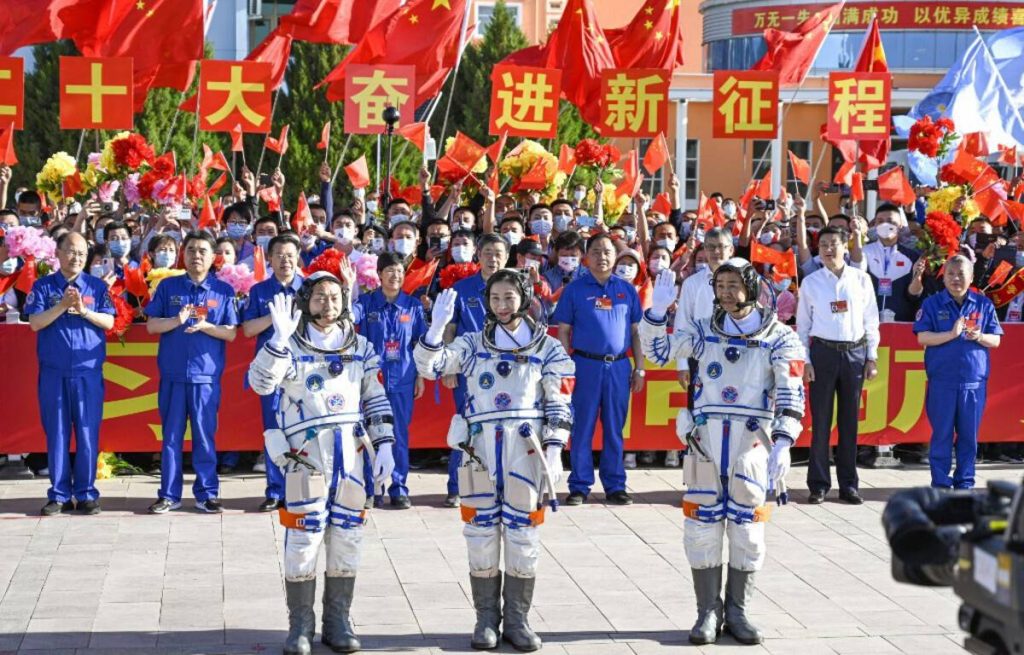
Three astronauts took off to the Chinese space station on Sunday
Tiangong – “Heavenly Palace” In Chinese – Prepares to welcome new guests… Three astronauts successfully flew last Sunday to the space station that Beijing is building in orbit.
The spacecraft for their Shenzhou-14 mission was powered by a Long March 2F rocket, which lifted off at 10:44 a.m. local time (0244 GMT) from the launch center in Jiuquan, in the Gobi Desert (Northwest). Public broadcaster CCTV broadcast live footage from the launch.
Six months on board
A quarter of an hour later, an official from the space agency responsible for manned flights (CMSA) declared the launch a “success.” Like the previous crew of the Shenzhou-13 mission, which returned in mid-April, the three astronauts, including a woman, are expected to stay on the space station for about six months.
Named in Chinese for Tiangong (“Heavenly Palace”) but also known by its acronym CSS (for “Chinese Space Station” in English), it should be fully operational by the end of the year.
The crew particularly includes Liu Yang, 43, who was the first Chinese woman in space (2012). She will be accompanied by Chen Dong, 43, and Kai Xuzhi, 46, who is making her first space flight after 12 years of preparation.
Continue to build Tiangong
The main challenge for the Shenzhou-14 crew: receipt and installation of two new laboratory units, which will be moored at the station. It will be launched from Earth in July and October. This will significantly increase the size and range of the space station. “After the modules are successfully docked, the crew will need to use a robotic arm to grab them, untie them, rotate them 90 degrees, and dock them at another port,” said Chen Lan, an analyst at Go Taikonauts.com, who specializes in the field. Chinese space programme.
These critical actions must be carried out in coordination with the engineers on the ground. “China has never done such a complex operation before, which has only been done at Mir and the International Space Station (ISS). It will be a real test for the crew and equipment,” said Chen Lan.
Once these laboratory units are installed, the overall structure of the station will be final, in the shape of a T. It will then be similar in size to the former Russian Soviet Mir station. Its life span should be at least 10 years, up to 15 years.
Towards the permanent occupation of Tiangong
The Shenzhou-14 crew will also conduct a spacewalk, conduct a series of experiments and conserve Tiangong.
New to this mission: For the first time, two Chinese crews will pass the baton in orbit at the station. Towards the end of their stay, before returning to Earth, the three Shenzhou-14 astronauts will actually spend a few days in orbit with their three colleagues on the future Shenzhou-15 mission.
« Avec Shenzhou-14, les vols spatiaux habités chinois passent une nouvelle étape » avec « le début de l’occupation permanente de la station », déclare à l’AFP Jonathan McDowell, astronome au Center Harvard-Smithsonian pour l’astroque, aux United State. “In other words, from now on, the goal is to always have Chinese astronauts in space.”
China banned from the International Space Station
China was pushed to build its own station eN due to his exclusion from the International Space StationBecause the United States prevents NASA from any cooperation with Beijing. The Asian giant has invested billions of euros in its space program for several decades.
China sent its first astronaut into space in 2003. Since then, it has made some notable achievements, especially in recent years. At the beginning of 2019, a machine was placed on the far side of the moon, for the first time in the world. In 2020, it returned samples from the Moon and completed the BeiDou Navigation Satellite System, a competitor to the US Global Positioning System (GPS).
In 2021, it has landed a small robot on Mars and plans to send men to the moon by 2030. In the long term, China plans to offer space tourism, said Zhou Jianping in March, the leader of the Chinese manned program.

“Organizer. Social media geek. General communicator. Bacon scholar. Proud pop culture trailblazer.”
